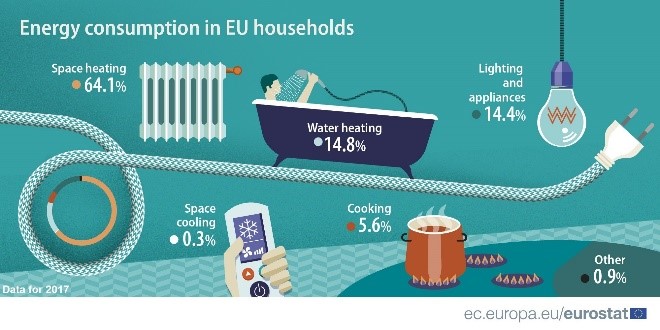Energy consumption per household depends on a number of variables such as the size of the home, its location, the construction materials used, the number of people living in the household, the number, power and frequency of use of electrical appliances. Thus, the principle applies that the bigger and older the home, the more people there are in the household and the older and more appliances are used – the higher the energy consumption will be.
According to the INS, energy consumption in Romania increased by +7.9% in 2021, compared to 2020. Increases were recorded in all economic activities, but the most significant was that generated by population consumption. As a share of the total final energy consumption, population consumption kept its first place (34.5%), followed by transport and industry, with 27.5% and 27.1% respectively – SOURCE 1, SOURCE 2, SOURCE 3.
Find details on how to read the meter depending on the type you have installed on the dedicated website www.autocitiri.ro!
In 2022, for the first eight months, amid the unprecedented increase in energy prices, the final consumption of electricity was 35,151.9 million kWh, 5.3% lower than the corresponding period of 2021, while the consumption of final electricity in the economy decreased by 4.5%. Public lighting increased by 3.8% and household consumption decreased by 7.7%, even though the price was capped. People have been much more careful with what they consume. Eliminating energy waste is a natural and very useful action regardless of how much it costs our utilities. Conventional energy resources are polluting and will gradually be replaced by clean energy sources.
The biggest consumers of energy inside the house
There are many ways we can reduce energy consumption in our homes. The first step is to understand which appliances use the most power, then find ways to optimize how we use them. Room heating and cooling, as well as the water heating system, account for almost 80% of household energy consumption. Electricity used for lighting and most electrical appliances accounts for 14.5% (this excludes the use of electricity to power the main heating, cooling or cooking systems), while the proportion used for water heating is slightly higher at 15.1% – SOURCE.
In the kitchen, the refrigerator is one of the household appliances with an annual consumption that can vary from 170 to 500 kWh, depending on the energy class. The induction hob consumes over 200 kWh/year. The washing machine consumes approximately 270 kWh annually, and the clothes dryer between 200 and 500 kWh. In the living room, the TV produces the highest annual consumption, over 400 kWh, for 4 hours of daily operation. For equipment that cannot be disconnected from electricity, such as refrigerators or freezers, it is advisable to purchase models with high energy efficiency, class A. The weight of the savings achieved, but also the reduction of the negative impact on the environment, are clear arguments for replacing the equipment used appliances.
Energy saving means controlling consumption without compromising comfort, and consumers need to know that they can do this through simple gestures, from using lighting fixtures and appliances with low energy consumption to larger and more expensive projects such as insulation heating of the home or the installation of photovoltaic panels.
How do we monitor home consumption?
Knowing the electrical energy consumption of household appliances is always the first step towards saving electricity. Before we start reducing electricity, it is very important to measure the electricity consumption of all connected appliances.
A quick way to find out consumption data is to use wattmeters. These are smart sockets that allow determining the amount of electricity consumed by a piece of equipment in a certain time unit and calculating its cost, according to the specific tariff for 1 kWh.
But the best way to keep your energy consumption under control is the meter data. By reading the monthly consumption index and sending it to the supplier with whom you have the contract, you will pay for the energy actually consumed, not the estimated one, and the adjustments will be modest. Knowing energy consumption data helps to evaluate costs, plan them and, if necessary, reduce energy waste. The energy we don’t use or save is the most important resource we have at our disposal, not only to optimize the costs on our bills, but also to protect the environment.
